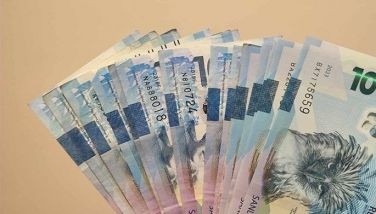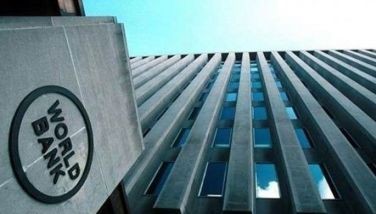BOP posts $2.4-B surplus in 2005
January 17, 2006 | 12:00am
The Bangko Sentral ng Pilipinas (BSP) reported yesterday that the country’s balance of payment (BOP) position posted a surplus of $273 million in December 2005 as against a deficit of $170 million in November 2005.
On a year-to-year basis, the BOP surplus continued to improve to $2.4 billion as of end-December 2005 from a deficit of $280 million in the same period in 2004 and end-November’s level of $2.13 billion.
The December 2005 BOP surplus was an improvement over the $177-million surplus registered in the same period in 2004.
The BSP attributed the substantial improvement in the country’s BOP position to increased investments, borrowings and remittances from abroad during the period.
The central monetary authority also noted that there was a decline in debt service obligations for the period.
As of end-2005, the debt service of BSP stood at $1.5 billion while the National Government paid about $4.8 billion.
Foreign portfolio investments during the period were recorded at $2.1 billion. The foreign direct investment target for the period was only $971 million.
Remittances of overseas Filipino workers (OFWs) reached $9.7 billion as of end-November 2005. For the whole of 2005, the government expects OFW remittances to reach $10.7 billion.
The National Governments’ commercial borrowings stood at $4.3 billion as of end-December 2005 while BSP borrowed $500 million during the period.
The BSP expects the BOP to continue posting a surplus this year despite the continuing rise in global crude prices.
The BOP is seen to modestly increase to $900 million in 2006 from the projected $853 million in 2005.
The BOP assumptions are based on the average Dubai crude, the benchmark being used by local oil refiners in pricing their products. From an average of $49.92 per barrel this year, the Dubai crude is expected to settle at between $56-$60 per barrel in 2006.
The BOP is used by monetary authorities to measure the country’s ability to pay its foreign debts as this represents the international reserves after interest payments and trade with the rest of the world.
The level of the gross international reserves (GIR) is also seen to improve to $18 billion to $18.6 billion in 2006 from a $17-billion assumption in 2005. This 2006 GIR level can cover four months of imports.
As of end-November 2005, the country’s GIR reached $18.1 billion, surpassing the whole-year 2004 level of $17-billion due to strong inflows from OFW remittances.
For 2006, the exchange rate is assumed to range between P55 to P57 to a dollar.
The BSP also expects the country’s exports to improve to $47.14 billion in 2006 from $42.85 billion in 2005.
Imports, on the other hand, will also expand to $53.77 billion this year from last year’s projected level of $48.44 billion.
The current account (CA), meanwhile, is expected to grow to $2.17 billion in 2006 as against $1.59 billion in 2005. CA consists of the aggregate balance of goods, services, income and current transfers. This account measures the net transfer of real resources between the domestic economy and the rest of the world.
On a year-to-year basis, the BOP surplus continued to improve to $2.4 billion as of end-December 2005 from a deficit of $280 million in the same period in 2004 and end-November’s level of $2.13 billion.
The December 2005 BOP surplus was an improvement over the $177-million surplus registered in the same period in 2004.
The BSP attributed the substantial improvement in the country’s BOP position to increased investments, borrowings and remittances from abroad during the period.
The central monetary authority also noted that there was a decline in debt service obligations for the period.
As of end-2005, the debt service of BSP stood at $1.5 billion while the National Government paid about $4.8 billion.
Foreign portfolio investments during the period were recorded at $2.1 billion. The foreign direct investment target for the period was only $971 million.
Remittances of overseas Filipino workers (OFWs) reached $9.7 billion as of end-November 2005. For the whole of 2005, the government expects OFW remittances to reach $10.7 billion.
The National Governments’ commercial borrowings stood at $4.3 billion as of end-December 2005 while BSP borrowed $500 million during the period.
The BSP expects the BOP to continue posting a surplus this year despite the continuing rise in global crude prices.
The BOP is seen to modestly increase to $900 million in 2006 from the projected $853 million in 2005.
The BOP assumptions are based on the average Dubai crude, the benchmark being used by local oil refiners in pricing their products. From an average of $49.92 per barrel this year, the Dubai crude is expected to settle at between $56-$60 per barrel in 2006.
The BOP is used by monetary authorities to measure the country’s ability to pay its foreign debts as this represents the international reserves after interest payments and trade with the rest of the world.
The level of the gross international reserves (GIR) is also seen to improve to $18 billion to $18.6 billion in 2006 from a $17-billion assumption in 2005. This 2006 GIR level can cover four months of imports.
As of end-November 2005, the country’s GIR reached $18.1 billion, surpassing the whole-year 2004 level of $17-billion due to strong inflows from OFW remittances.
For 2006, the exchange rate is assumed to range between P55 to P57 to a dollar.
The BSP also expects the country’s exports to improve to $47.14 billion in 2006 from $42.85 billion in 2005.
Imports, on the other hand, will also expand to $53.77 billion this year from last year’s projected level of $48.44 billion.
The current account (CA), meanwhile, is expected to grow to $2.17 billion in 2006 as against $1.59 billion in 2005. CA consists of the aggregate balance of goods, services, income and current transfers. This account measures the net transfer of real resources between the domestic economy and the rest of the world.
BrandSpace Articles
<
>
- Latest
- Trending
Trending
Latest























